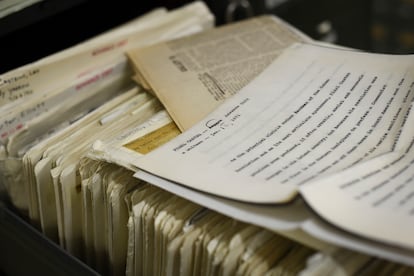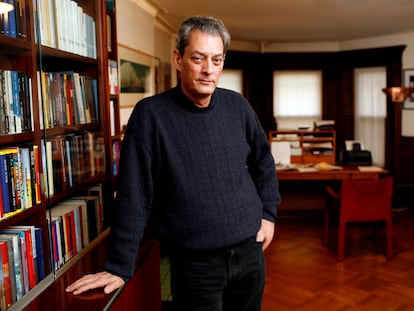
In the ‘morgue’ of ‘The New York Times’
The genre can be a literary gem when it is written with the dedication seen at the U.S. newspaper, which prepares advance obituaries
When the novelist John Barth died last April, The New York Times published an obituary signed by two journalists, Dwight Garner, a renowned literary critic, and Michael T. Kaufman, who, as clarified in a note, had died in 2010 — in other words, 14 years before Barth himself. Kaufman had written what is known in Times journalism parlance as an “advance obituary.” Garner’s mission was to finish off what Kaufman had prepared. The best profile ever written about an obituary writer is probably Mr. Bad News, published in Esquire magazine in 1966 by Gay Talese. In Mr. Bad News, Talese says that the newspaper’s morgue — as he calls the obituary section — contains some 2,000 advance obituaries on file, all of them duly written and updated, just waiting for the protagonist of the obituary in question to pass away so that the circumstances of their death could be added. Mr. Bad News was Alden Whitman, author of half a thousand obituaries on some of the most famous people of his time. Whitman died suddenly in 1990 at the age of 76 at the Paris Hotel in Monte Carlo, where he had gone with his wife, Joan, to celebrate the 70th birthday of a Times colleague, who was a culinary specialist.
The obituary headline highlighted that Whitman’s greatest merit was having elevated the humble genre of obituaries to the category of art. What’s most striking about the bold technique developed by Whitman was the practice of interviewing the subject of the obituary while they were alive: he requested an interview by letter and, surprisingly, more than one agreed to it. The idea, as Whitman explained in the prefaces to his two collections of obituaries, was to get to the depths of the character’s personality, something that is only possible in a conversation.
Whitman wrote the obituaries of T. S. Eliot, Le Corbusier, Albert Schweitzer, Jean Arp, Robert Oppenheimer, Alice B. Toklas, Dorothy Parker, Ilya Ehrenburg, André Maurois, Helen Keller, John Steinbeck, Boris Karloff, Mies van der Rohe, Ho Chi Minh, Bertrand Russell, Alexander Kerenski, Pablo Picasso and Charles Lindbergh, among others. One in 10, according to Whitman, agreed to be interviewed. This list included former U.S. president Harry S. Truman, who initially resisted and finally gave in. With others, such as Lindbergh, he formed a solid friendship.
The author of Whitman’s obituary, Sidney Zion, died in 2009, and Zion’s obituary was written by another great specialist of the genre, Robert McFadden, winner of the Pulitzer Prize, among other awards. In the note in which he explains to his Times readers what his work entails, McFadden, 87, points out that throughout his life he has written a total of 750 advance obituaries. Of course, the work doesn’t stop with him. The New York Times morgue evoked by Talese in his masterful profile has never stopped growing and being updated. Without the slightest doubt, the advance obituary of the 92-year-old author is there, as are — it is chilling to think about — those of Don DeLillo or Thomas Pynchon, as was until recently that of Paul Auster.
What is not known is who they will ask to write Talese’s advance obituary, or if the journalist in charge will ask to interview him. You’d have to ask them.
Sign up for our weekly newsletter to get more English-language news coverage from EL PAÍS USA Edition
Tu suscripción se está usando en otro dispositivo
¿Quieres añadir otro usuario a tu suscripción?
Si continúas leyendo en este dispositivo, no se podrá leer en el otro.
FlechaTu suscripción se está usando en otro dispositivo y solo puedes acceder a EL PAÍS desde un dispositivo a la vez.
Si quieres compartir tu cuenta, cambia tu suscripción a la modalidad Premium, así podrás añadir otro usuario. Cada uno accederá con su propia cuenta de email, lo que os permitirá personalizar vuestra experiencia en EL PAÍS.
¿Tienes una suscripción de empresa? Accede aquí para contratar más cuentas.
En el caso de no saber quién está usando tu cuenta, te recomendamos cambiar tu contraseña aquí.
Si decides continuar compartiendo tu cuenta, este mensaje se mostrará en tu dispositivo y en el de la otra persona que está usando tu cuenta de forma indefinida, afectando a tu experiencia de lectura. Puedes consultar aquí los términos y condiciones de la suscripción digital.
More information
Archived In
Últimas noticias
Maduro pleads not guilty before the federal court in New York: ‘I am still the president of Venezuela’
A new test can detect Alzheimer’s from a finger prick
UN team enters Sudanese city of El Fasher after paramilitary massacre: ‘It’s like a ghost town’
A recipe for resistance: Indigenous peoples politicize their struggles from the kitchen
Most viewed
- Gilles Lipovetsky: ‘If you want to live better and fall in love, take Prozac, don’t look to philosophy’
- Alain Aspect, Nobel laureate in physics: ‘Einstein was so smart that he would have had to recognize quantum entanglement’
- Alvin Hellerstein, a 92-year-old judge appointed by Bill Clinton, to preside over Maduro’s trial in New York
- Why oil has been at the center of Venezuela-US conflicts for decades
- Cuba confirms death of 32 of its citizens in the US attack against Venezuela









































